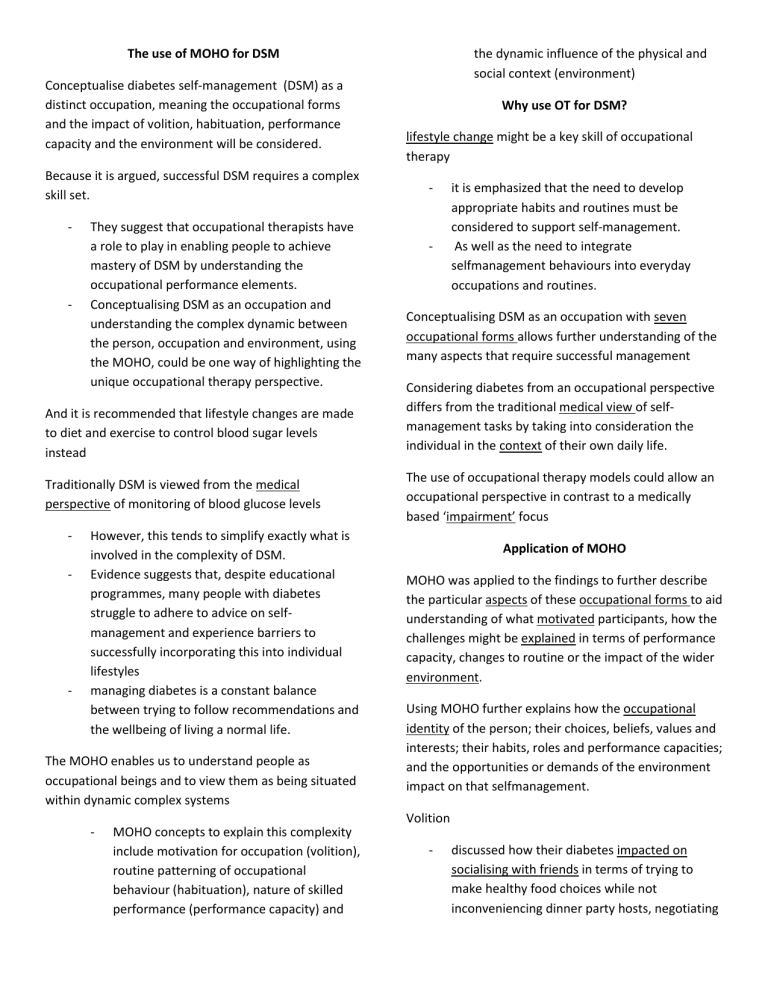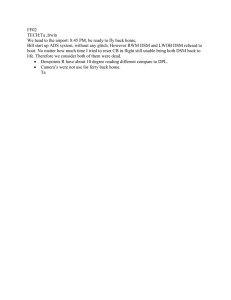MOHO in Diabetes Self-Management: An Occupational Therapy Approach
advertisement

the dynamic influence of the physical and social context (environment) The use of MOHO for DSM Conceptualise diabetes self-management (DSM) as a distinct occupation, meaning the occupational forms and the impact of volition, habituation, performance capacity and the environment will be considered. Because it is argued, successful DSM requires a complex skill set. - - They suggest that occupational therapists have a role to play in enabling people to achieve mastery of DSM by understanding the occupational performance elements. Conceptualising DSM as an occupation and understanding the complex dynamic between the person, occupation and environment, using the MOHO, could be one way of highlighting the unique occupational therapy perspective. And it is recommended that lifestyle changes are made to diet and exercise to control blood sugar levels instead Traditionally DSM is viewed from the medical perspective of monitoring of blood glucose levels - - However, this tends to simplify exactly what is involved in the complexity of DSM. Evidence suggests that, despite educational programmes, many people with diabetes struggle to adhere to advice on selfmanagement and experience barriers to successfully incorporating this into individual lifestyles managing diabetes is a constant balance between trying to follow recommendations and the wellbeing of living a normal life. The MOHO enables us to understand people as occupational beings and to view them as being situated within dynamic complex systems - MOHO concepts to explain this complexity include motivation for occupation (volition), routine patterning of occupational behaviour (habituation), nature of skilled performance (performance capacity) and Why use OT for DSM? lifestyle change might be a key skill of occupational therapy - - it is emphasized that the need to develop appropriate habits and routines must be considered to support self-management. As well as the need to integrate selfmanagement behaviours into everyday occupations and routines. Conceptualising DSM as an occupation with seven occupational forms allows further understanding of the many aspects that require successful management Considering diabetes from an occupational perspective differs from the traditional medical view of selfmanagement tasks by taking into consideration the individual in the context of their own daily life. The use of occupational therapy models could allow an occupational perspective in contrast to a medically based ‘impairment’ focus Application of MOHO MOHO was applied to the findings to further describe the particular aspects of these occupational forms to aid understanding of what motivated participants, how the challenges might be explained in terms of performance capacity, changes to routine or the impact of the wider environment. Using MOHO further explains how the occupational identity of the person; their choices, beliefs, values and interests; their habits, roles and performance capacities; and the opportunities or demands of the environment impact on that selfmanagement. Volition - discussed how their diabetes impacted on socialising with friends in terms of trying to make healthy food choices while not inconveniencing dinner party hosts, negotiating - - - - - the refusal of food gifts and of feeling a nuisance or spoiling others’ pleasure. it was clear from the participants that how successful they were with these occupational forms was bound up in values and interests. Managing diet, for some, resulted in reduced food choices and feelings of exclusion while shopping for food and having to make efforts not to give in to temptation, as found by Wellard et al. (DEFINITION) are interwoven and it is the relationship between these components which influences how people assess and manage themselves. For participants their ability to engage with the occupational forms of DSM was bound up with their beliefs about themselves and their trust in professionals For Frances, dealing with this conflicting information not only impacted on her sense of capacity to manage but was also at odds with her conviction that health professionals should provide clear information to work with. o “led some to insisting on seeing the same person as ‘I was being given different advice by different people everytime I went” Some participants felt that the frequency of appointments did not suit them and the impact of their personal causation was explained in terms of wanting reassurance that they were doing the right thing o Issues of trust, power and communication characterised the therapeutic relationship, o concerned about being judged by professionals or wanting to please by adhering to advice as far as possible - - Performance capacity - participants talked about the physical understanding of symptoms and the cognitive ability required to work out medical equipment and understand results o requiring participants to be aware of their safety limits and planning Medication management formed a major part of DSM for the participants. In terms of performance capacity this involved working out timing of medication, dealing with changes to medication and possible risk factors, incorporating new equipment, calibrating insulin amounts in relation to diet and exercise, making choices about where and when to inject Environment - Habituation - beforehand to ensure adequate supplies of medication or emergency glucose. This was clearly associated with roles and routines as well as personal causation. Routines required changing and sometimes careful planning Some participants discussed the difficulty of fitting appointments around home and work routines as well as the need to change routines around food, exercise and testing. Participants had to learn to override the habit to eat when stressed, change meal routines in relation to medication Some found exercise had a very positive impact on their diabetes, such as Susan, who found sport to be ‘my medicine’ but others found routines hard to sustain. Participants had to over-come exercise reluctanc - Overall, dealing with the culture of blame across these occupational forms added another layer of difficulty for the participants. Browne et al. (2013) discuss the negative impact of stigma and how negative or oversimplified views of diabetes can be experienced from friends, society in general, the media and healthcare professionals. Participants described how unhelpful and demotivating this culture of blame could be The lack of available facilities in the physical environment constrained how well DSM was managed. Conclusion Because people can live long and healthy lives if diabetes is well managed and type 2 diabetes can be prevented with lifestyle changes to diet and exercise to control blood sugar levels - MOHO was considered as a way of conceptualising and understanding the complexity of the occupation of DSM with its seven inter-related occupational forms. This has highlighted the complexity of an individual managing DSM in the context of their own lives and the multiple and complex systems that this entails, which goes beyond the biomedical approach Importance: This study, embedded in the experiences of those with diabetes, suggests that there is a role for occupational therapy in DSM, and that occupational therapy has a distinct role through seeing this selfmanagement as an occupation


